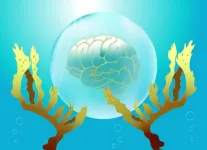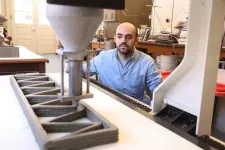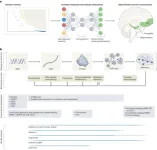Preventing Parkinson’s disease may lie in seaweed antioxidants
Ecklonia cava, a brown algae seaweed, is shown to have the ability to protect against neurodegeneration
2024-08-05
(Press-News.org)
Parkinson’s disease is a neurodegenerative disease caused by the loss of neurons that produce dopamine, a neurotransmitter involved in motor control and cognitive function. As the global population ages, the number of Parkinson's disease patients is rapidly increasing. Parkinson's disease is induced by neuronal damage due to excessive production of reactive oxygen species.
Suppression of reactive oxygen species generation is essential because it is fatal to dopaminergic neurons that manage dopamine neurotransmitters. Currently, only symptomatic treatment is available, so the development of treatment regimens and prevention methods is necessary.
Fortunately, Associate Professor Akiko Kojima-Yuasa of Osaka Metropolitan University’s Graduate School of Human Life and Ecology led a research group that has verified the physiological effect of Ecklonia cava polyphenols, seaweed antioxidants, on the prevention of Parkinson’s disease.
In this study, two types of motor function tests were conducted using Parkinson’s disease model mice that were orally fed the antioxidants daily for one week and then administered rotenone. Results showed that motor function, which was decreased by rotenone, was restored. There was also improvement in intestinal motor function and the colon mucosa structure, a special tissue that covers the colon.
Further, cellular experiments using Parkinson’s disease model cells verified the biochemical interaction of the preventive effect of Ecklonia cava. Validation results showed that the antioxidants activate the AMPK enzyme (adenosine monophosphate-activated protein kinase), an intracellular energy sensor, and inhibit the production of reactive oxygen species that cause neuronal cell death.
“This study suggests that Ecklonia cava antioxidants may reduce neuronal damage by AMPK activation and inhibiting intracellular reactive oxygen species production,” stated Professor Kojima-Yuasa. “It is hoped that Ecklonia cava will be an effective ingredient in the prevention of Parkinson’s disease.”
###
About OMU
Established in Osaka as one of the largest public universities in Japan, Osaka Metropolitan University is committed to shaping the future of society through “Convergence of Knowledge” and the promotion of world-class research. For more research news, visit https://www.omu.ac.jp/en/ and follow us on social media: X, Facebook, Instagram, LinkedIn.
END
ELSE PRESS RELEASES FROM THIS DATE:
2024-08-05
Light pollution disrupts circadian rhythms and ecosystems worldwide – but for plants, dependent on light for photosynthesis, its effects could be profound. Now scientists writing in Frontiers in Plant Science have found that exposure to high levels of artificial light at night makes tree leaves grow tougher and harder for insects to eat, threatening urban food chains.
“We noticed that, compared to natural ecosystems, tree leaves in most urban ecosystems generally show little sign of insect damage. We were curious as to why,” said corresponding author Dr Shuang Zhang of the Chinese Academy of Sciences. “Here we show that in ...
2024-08-04
Mental health screenings must be incorporated in routine prostate cancer diagnoses say University of South Australia researchers. The call follows new research that shows men need more supports both during and immediately after a diagnosis of prostate cancer.
Funded by Movember, the UniSA study tracked the scale and timing of mental health issues among 13,693 South Australian men with prostate cancer, finding that 15% of prostate cancer patients began mental health medications directly after a prostate cancer diagnosis, with 6% seeking help from mental health ...
2024-08-03
WASHINGTON – Three high-impact steps could be taken by global health leaders to reshape the global regulatory framework and help address the pressing need for equitable access to diagnostics, therapeutics, and vaccines during public health emergencies, say a Georgetown global health law expert and a medical student.
In their “Perspective” published today in the New England Journal of Medicine, Georgetown School of Health professor Sam Halabi, JD, and George O’Hara, a Georgetown medical student and David E. Rogers Student ...
2024-08-03
Tokyo, Japan – Researchers from Tokyo Metropolitan University have taken a big step in solving the mystery around why animals evolve sex chromosomes. It had long been proposed that sex chromosomes evolve to reduce “sexual conflict,” the evolution of features which are sub-optimal for either sex. By using fruit flies, the team showed that genes on newly formed neo-sex chromosomes in fruit flies tend to evolve “sex-biased genes” which give sex-specific phenotypes.
Chromosomes are neatly packaged bundles of DNA that carry all the genetic material of an organism. While prokaryotes ...
2024-08-02
A research team led by engineers at the University of Virginia School of Engineering and Applied Science is the first to explore how an emerging plant-based material, cellulose nanofibrils, could amplify the benefits of 3D-printed concrete technology.
“The improvements we saw on both printability and mechanical measures suggest that incorporating cellulose nanofibrils in commercial printable materials could lead to more resilient and eco-friendly construction practices sooner rather than later,” said Osman E. Ozbulut, a professor in the Department of Civil and Environmental ...
2024-08-02
Technology with roots going back to the Bronze Age may offer a fast and inexpensive solution to help achieve the United Nations climate goal of net zero emissions by 2050, according to recent Stanford-led research in PNAS Nexus.
The technology involves assembling heat-absorbing bricks in an insulated container, where they can store heat generated by solar or wind power for later use at the temperatures required for industrial processes. The heat can then be released when needed by passing air through channels in the stacks of “firebricks,” thus allowing cement, steel, glass, and paper factories to run on renewable energy even when wind and sunshine ...
2024-08-02
Patrick Sullivan, MD, FRANZCP, the Yeargan Distinguished Professor of Psychiatry and Genetics at the UNC School of Medicine, and researchers at the Karolinska Institutet in Stockholm, Sweden, have developed a comprehensive outline of the genetics of schizophrenia. The review was published in Nature Reviews Neuroscience.
Schizophrenia is a neuropsychiatric disorder featuring recurrent episodes of psychosis – such as hallucinations, delusions, and disorganized thinking – with many patients developing apathy, social withdrawal, ...
2024-08-02
In a new review paper, researchers from the Universities of Arizona, Oxford and Leeds analyzed dozens of previous studies into long COVID to examine the number and range of people affected, the underlying mechanisms of disease, the many symptoms that patients develop, and current and future treatments.
Long COVID, also known as Post-COVID-19 condition, is generally defined as symptoms persisting for three months or more after acute COVID-19. The condition can affect and damage many organ systems, leading to severe ...
2024-08-02
COLUMBUS, Ohio – The rising earth beneath the Antarctic Ice Sheet will likely become a major factor in future sea level rise, a new study suggests.
Despite feeling like a stationary mass, most solid ground is undergoing a process of deformation, sinking and rising in response to many environmental factors. In Antarctica, melting glacial ice means less weight on the bedrock below, allowing it to rise. How the rising earth interacts with the overlying ice sheet to affect sea level rise is not well-studied, said Terry Wilson, co-author of the study and a senior research scientist at the Byrd Polar and Climate Research Center ...
2024-08-02
Rebecca Robbins, PhD, of the Division of Sleep and Circadian Disorders at Brigham and Women’s Hospital, is the senior author of a paper published in Psychiatry Research, “Exploring sleep difficulties, alcohol, illicit drugs, and suicidal ideation among adolescents with a history of depression.”
How would you summarize your study for a lay audience?
Suicide is one of the leading causes of death for adolescents in the U.S. We know, due to previous research, that difficulty falling asleep or waking up too early as well as abuse of prescription ...
LAST 30 PRESS RELEASES:
[Press-News.org] Preventing Parkinson’s disease may lie in seaweed antioxidants
Ecklonia cava, a brown algae seaweed, is shown to have the ability to protect against neurodegeneration





